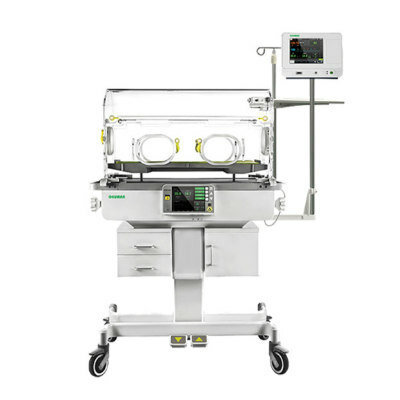Handheld Fluorescence Imaging Device Aids Wound Management 
|
By HospiMedica International staff writers Posted on 16 Dec 2019 |

Image: The MolecuLight i:X handheld device uses fluorescence imaging to identify bacteria (Photo courtesy of MolecuLight)
A portable fluorescence imaging device enables real time point-of-care (POC) visualization of bacterial presence in wounds, digitally recording images and area measurements.
The MolecuLight (Toronto, Canada) i:X device aids visualization and quantitative tracking of bacterial contamination, wound healing, and connective tissue remodeling of surgical sites and wounds, by the analysis of intrinsic fluorescence signals resulting from illumination with a violet light. The narrow band emitted light causes endogenous fluorophores in the bacteria to fluoresce, without the need of contrast agents. Images can be captured and documented as either stills or videos, including in the surrounding areas where more potentially harmful bacteria may be lurking.
Studies have shown the device can enable real-time POC visualization of discrete focal areas of bacterial colonization in midline abdominal wounds, with a sensitivity of 80% and a specificity of 70%, helping to reduce the likelihood of administering unnecessary antibiotic treatment. Susceptible bacteria include methicillin-resistant Staphylococcus aureus (MRSA); Pseudomonas aeruginosa; Escherichia coli; Coagulase-negative staphylococci; multiple Enterococcus species; multiple Proteus species; Klebsiella pneumonia; Beta-hemolytic streptococci (Group B); and multiple Enterobacter species.
“Identifying wounds with bacterial loads higher than 104 CFU/g at the point-of-care enables the clinician using the MolecuLight i:X to provide more appropriate, targeted treatment,” said Anil Amlani, CEO of MolecuLight. “Our clinical study results demonstrate that the i:X used in combination with clinical signs and symptoms significantly increases the ability of clinicians to identify wounds with the presence of these bacterial loads, when compared with wound assessment based on clinical signs and symptoms alone.”
Low-intensity violet light in the 405 nm range excites tissues and bacteria within and around a wound, causing healthy tissues to fluoresce green, while bacteria fluoresce in either red or cyan. This enables their immediate localization; and while surface bacteria generally appear as a brighter red, subsurface bacteria at the maximal detectable depth of about 1.5 mm appear more blush-colored.
Related Links:
MolecuLight
The MolecuLight (Toronto, Canada) i:X device aids visualization and quantitative tracking of bacterial contamination, wound healing, and connective tissue remodeling of surgical sites and wounds, by the analysis of intrinsic fluorescence signals resulting from illumination with a violet light. The narrow band emitted light causes endogenous fluorophores in the bacteria to fluoresce, without the need of contrast agents. Images can be captured and documented as either stills or videos, including in the surrounding areas where more potentially harmful bacteria may be lurking.
Studies have shown the device can enable real-time POC visualization of discrete focal areas of bacterial colonization in midline abdominal wounds, with a sensitivity of 80% and a specificity of 70%, helping to reduce the likelihood of administering unnecessary antibiotic treatment. Susceptible bacteria include methicillin-resistant Staphylococcus aureus (MRSA); Pseudomonas aeruginosa; Escherichia coli; Coagulase-negative staphylococci; multiple Enterococcus species; multiple Proteus species; Klebsiella pneumonia; Beta-hemolytic streptococci (Group B); and multiple Enterobacter species.
“Identifying wounds with bacterial loads higher than 104 CFU/g at the point-of-care enables the clinician using the MolecuLight i:X to provide more appropriate, targeted treatment,” said Anil Amlani, CEO of MolecuLight. “Our clinical study results demonstrate that the i:X used in combination with clinical signs and symptoms significantly increases the ability of clinicians to identify wounds with the presence of these bacterial loads, when compared with wound assessment based on clinical signs and symptoms alone.”
Low-intensity violet light in the 405 nm range excites tissues and bacteria within and around a wound, causing healthy tissues to fluoresce green, while bacteria fluoresce in either red or cyan. This enables their immediate localization; and while surface bacteria generally appear as a brighter red, subsurface bacteria at the maximal detectable depth of about 1.5 mm appear more blush-colored.
Related Links:
MolecuLight
Latest Critical Care News
- Deep-Learning Model Predicts Arrhythmia 30 Minutes before Onset
- Breakthrough Technology Combines Detection and Treatment of Nerve-Related Disorders in Single Procedure
- Plasma Irradiation Promotes Faster Bone Healing
- New Device Treats Acute Kidney Injury from Sepsis
- Study Confirms Safety of DCB-Only Strategy for Treating De Novo Left Main Coronary Artery Disease
- Revascularization Improves Quality of Life for Patients with Chronic Limb Threatening Ischemia
- AI-Driven Prediction Models Accurately Predict Critical Care Patient Deterioration
- Preventive PCI for High-Risk Coronary Plaques Reduces Cardiac Events
- AI Diagnostic Tool Guides Rapid Diagnosis and Prediction of Sepsis
- World's First AI-Powered Sepsis Alert System Detects Sepsis in One Minute
- Smartphone Magnetometer Uses Magnetized Hydrogel to Measure Biomarkers for Disease Diagnosis
- New Technology to Revolutionize Valvular Heart Disease Care
- Super Permeable Wearable Electronics Enable Long-Term Biosignal Monitoring
- New Hydrogel Features Enhanced Capabilities for Treating Aneurysms and Halting Progression
- New AI Tool Predicts Medical Events to Support Clinical Decision-Making in Healthcare Settings
- Bioelectronic Mesh Grows With Cardiac Tissues for Comprehensive Heart Monitoring
Channels
Artificial Intelligence
view channel
AI-Powered Algorithm to Revolutionize Detection of Atrial Fibrillation
Atrial fibrillation (AFib), a condition characterized by an irregular and often rapid heart rate, is linked to increased risks of stroke and heart failure. This is because the irregular heartbeat in AFib... Read more
AI Diagnostic Tool Accurately Detects Valvular Disorders Often Missed by Doctors
Doctors generally use stethoscopes to listen for the characteristic lub-dub sounds made by heart valves opening and closing. They also listen for less prominent sounds that indicate problems with these valves.... Read moreSurgical Techniques
view channel
Hydrogel-Based Miniaturized Electric Generators to Power Biomedical Devices
The development of engineered devices that can harvest and convert the mechanical motion of the human body into electricity is essential for powering bioelectronic devices. This mechanoelectrical energy... Read moreWearable Technology Monitors and Analyzes Surgeons' Posture during Long Surgical Procedures
The physical strain associated with the static postures maintained by neurosurgeons during long operations can lead to fatigue and musculoskeletal problems. An objective assessment of surgical ergonomics... Read more.jpg)
Custom 3D-Printed Orthopedic Implants Transform Joint Replacement Surgery
The evolving field of 3D printing is revolutionizing orthopedics, especially for individuals requiring joint replacement surgeries where traditional implants fail to provide a solution. Although most people... Read more
Cutting-Edge Imaging Platform Detects Residual Breast Cancer Missed During Lumpectomy Surgery
Breast cancer is becoming increasingly common, with statistics indicating that 1 in 8 women will develop the disease in their lifetime. Lumpectomy remains the predominant surgical intervention for treating... Read morePatient Care
view channel
Surgical Capacity Optimization Solution Helps Hospitals Boost OR Utilization
An innovative solution has the capability to transform surgical capacity utilization by targeting the root cause of surgical block time inefficiencies. Fujitsu Limited’s (Tokyo, Japan) Surgical Capacity... Read more
Game-Changing Innovation in Surgical Instrument Sterilization Significantly Improves OR Throughput
A groundbreaking innovation enables hospitals to significantly improve instrument processing time and throughput in operating rooms (ORs) and sterile processing departments. Turbett Surgical, Inc.... Read more
Next Gen ICU Bed to Help Address Complex Critical Care Needs
As the critical care environment becomes increasingly demanding and complex due to evolving hospital needs, there is a pressing requirement for innovations that can facilitate patient recovery.... Read moreGroundbreaking AI-Powered UV-C Disinfection Technology Redefines Infection Control Landscape
Healthcare-associated infection (HCAI) is a widespread complication in healthcare management, posing a significant health risk due to its potential to increase patient morbidity and mortality, prolong... Read moreHealth IT
view channel
Machine Learning Model Improves Mortality Risk Prediction for Cardiac Surgery Patients
Machine learning algorithms have been deployed to create predictive models in various medical fields, with some demonstrating improved outcomes compared to their standard-of-care counterparts.... Read more
Strategic Collaboration to Develop and Integrate Generative AI into Healthcare
Top industry experts have underscored the immediate requirement for healthcare systems and hospitals to respond to severe cost and margin pressures. Close to half of U.S. hospitals ended 2022 in the red... Read more
AI-Enabled Operating Rooms Solution Helps Hospitals Maximize Utilization and Unlock Capacity
For healthcare organizations, optimizing operating room (OR) utilization during prime time hours is a complex challenge. Surgeons and clinics face difficulties in finding available slots for booking cases,... Read more
AI Predicts Pancreatic Cancer Three Years before Diagnosis from Patients’ Medical Records
Screening for common cancers like breast, cervix, and prostate cancer relies on relatively simple and highly effective techniques, such as mammograms, Pap smears, and blood tests. These methods have revolutionized... Read morePoint of Care
view channel
Critical Bleeding Management System to Help Hospitals Further Standardize Viscoelastic Testing
Surgical procedures are often accompanied by significant blood loss and the subsequent high likelihood of the need for allogeneic blood transfusions. These transfusions, while critical, are linked to various... Read more
Point of Care HIV Test Enables Early Infection Diagnosis for Infants
Early diagnosis and initiation of treatment are crucial for the survival of infants infected with HIV (human immunodeficiency virus). Without treatment, approximately 50% of infants who acquire HIV during... Read more
Whole Blood Rapid Test Aids Assessment of Concussion at Patient's Bedside
In the United States annually, approximately five million individuals seek emergency department care for traumatic brain injuries (TBIs), yet over half of those suspecting a concussion may never get it checked.... Read more
New Generation Glucose Hospital Meter System Ensures Accurate, Interference-Free and Safe Use
A new generation glucose hospital meter system now comes with several features that make hospital glucose testing easier and more secure while continuing to offer accuracy, freedom from interference, and... Read moreBusiness
view channel
Johnson & Johnson Acquires Cardiovascular Medical Device Company Shockwave Medical
Johnson & Johnson (New Brunswick, N.J., USA) and Shockwave Medical (Santa Clara, CA, USA) have entered into a definitive agreement under which Johnson & Johnson will acquire all of Shockwave’s... Read more














